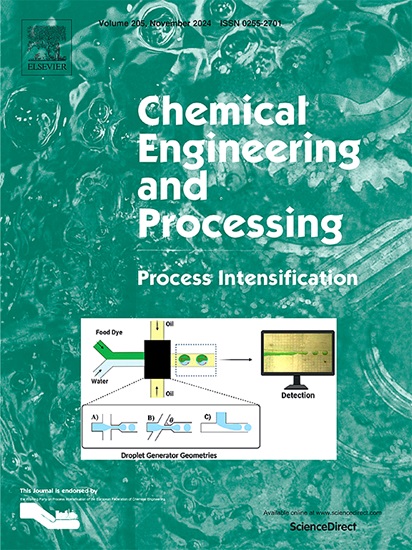Research on ultrasonic demulsification characteristics and parameter optimization of condensate oil emulsion
IF 3.8
3区 工程技术
Q3 ENERGY & FUELS
Chemical Engineering and Processing - Process Intensification
Pub Date : 2025-01-27
DOI:10.1016/j.cep.2025.110185
引用次数: 0
Abstract
As natural gas wells advance through the mid to late stages of extraction, foam drainage processes are employed to sustain production capacity, leading to the formation of significant condensate emulsions. This study examines the effects of key factors on separation efficiency during ultrasonic dewatering of two representative condensate emulsions with varying viscosities, using single-factor and orthogonal experiments. The droplet size distribution was assessed using a microscopic observation system before and after demulsification. Results indicate that ultrasonic demulsification is an effective method for treating condensate emulsions and improving recovery rates. Optimal parameters were determined as 0.5 W/cm², 20 kHz, and a processing time of 20 mins, achieving complete dewatering (100 %) for separated oil samples alongside a notable separation efficiency of 83.1 %. Importantly, increases in sound intensity and processing time initially enhanced separation efficiency but subsequently led to a decline. Frequency exerted the most substantial influence on separation efficiency, followed by sound intensity, processing time had the least effect. Furthermore, under identical conditions, the first oil sample demonstrated a separation efficiency that was 17.4 % greater than that of the second sample. In practical terms, reducing emulsion viscosity can enhance ultrasonic separation efficiency.

求助全文
约1分钟内获得全文
求助全文
来源期刊
CiteScore
7.80
自引率
9.30%
发文量
408
审稿时长
49 days
期刊介绍:
Chemical Engineering and Processing: Process Intensification is intended for practicing researchers in industry and academia, working in the field of Process Engineering and related to the subject of Process Intensification.Articles published in the Journal demonstrate how novel discoveries, developments and theories in the field of Process Engineering and in particular Process Intensification may be used for analysis and design of innovative equipment and processing methods with substantially improved sustainability, efficiency and environmental performance.

 求助内容:
求助内容: 应助结果提醒方式:
应助结果提醒方式:


